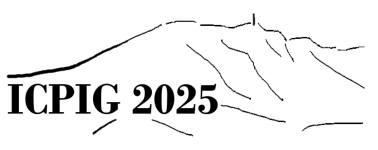|
|
|
ICPIG history > HistoryOrigins and Foundation The International Conference on Phenomena in Ionized Gases (ICPIG) was founded in 1953 in Oxford by Hans von Engel and Gordon Francis, inspired by the US Gaseous Electronics Conference (GEC), to establish a forum on gas discharge and plasma physics. Despite initial scepticism from the Physical Society, early meetings in Delft (1955), Venice (1957), and Uppsala (1959) confirmed its relevance [1][2]. Cold War Period During the Cold War, ICPIG adopted an East-West alternation, providing a rare opportunity for scientists from both blocs to meet and exchange knowledge despite travel restrictions [2]. Transition to a Global Conference ICPIG held its first edition outside Europe in Hoboken, USA (1995), and its first Asian edition in Nagoya, Japan (2001), which marked its 50th anniversary and gathered around 700 participants, one of the largest meetings in its history. Scientific Evolution Initially focused on fusion and basic plasma physics, ICPIG expanded to include low-temperature plasmas, plasma processing, environmental applications, and the study of electronegative plasmas, reflecting technological and societal [2]. Establishment and Evolution of Awards The Penning Prize, first awarded to Hans von Engel in 1991, became the von Engel Prize before evolving into the Engel & Franklin Prize around 2011, secured by the Gordon Francis Fund and Franklin’s personal support to ensure its continuity [2]. Structural Changes At the 1971 Oxford ICPIG, a formal constitution and a rotating membership structure for the International Scientific Committee (ISC) were established, ensuring transparent and sustainable governance [2]. Links with ESCAMPIG and GEC ICPIG, inspired by the GEC, found a complementary partner in ESCAMPIG (European Sectional Conference on Atomic and Molecular Phenomena in Ionized Gases), alternating schedules and fostering collaboration within the plasma community [2]. Anecdotes and Legacy Hans von Engel, born into Austro-Hungarian nobility, turned away from his family estate to pursue science. In the early 1930s, he and Max Steenbeck co-authored the first comprehensive textbook on gas discharges and low-temperature plasma physics, a work that shaped the field for decades. In 1939, von Engel left Germany, leaving behind his promising career at Siemens and a fruitful collaboration with Steenbeck. They would meet again years later, at the fourth ICPIG in Uppsala, each carrying the distinct paths they had followed through the intervening years. The first ICPIG in 1953 in Oxford established the conference’s scientific foundation. The main subjects discussed were spark, arc, glow and high frequency discharges, Geiger counters and several fundamental processes [3]. Landmark scientific milestones followed, including reports on Landau damping in Paris (1963) and advances in radio-frequency plasma generation. During the 1961 conference in Munich the Berlin Wall went up to the dismay of many, including Von Engel. Von Engel was sensitive to the position in Europe and what it meant for scientists. And so, until 1989 and the fall of the Berlin Wall, the conference alternated between countries in the Eastern and Western blocs Notable moments include the 1969 Bucharest meeting, held behind the Iron Curtain yet marked by unexpected openings to the West with young people who sang Beatles songs, a quiet gesture of connection beyond borders. It was during this conference that three members of the local committee, including Martha Bacal, decided to leave for the West, highlighting the tensions and hopes of the time [4]. Franklin [2] recounts many anecdotes illustrating the life of the ICPIG conference series. He notes that for the 1971 meeting in Oxford, the organizers considered their greatest achievement to be the delivery of the contributed papers to participants in their home countries six weeks before the conference—a logistical feat accomplished using the diplomatic bag for the USSR and the US Air Force for the United States. Franklin also describes the challenges faced during the 1973 Prague meeting, which took place under the tense atmosphere following the Prague Spring. In a 1977 television interview in Berlin, Hans von Engel remarked that organizing a conference was rather like having a baby. Recent Milestones In 2021, ICPIG was postponed due to the COVID-19 pandemic but successfully resumed its cycle in 2023 and 2025, maintaining its tradition of continuity and adaptation. First Chairwoman A key milestone in ICPIG history was the appointment of Professor Leanne Pitchford (France) as the first chairwoman during the 2003 Greifswald edition, marking progress in inclusivity and gender representation within the international plasma community, as noted by Franklin [2]. Conclusion ICPIG remains one of the longest-running and most respected international conferences in plasma physics, fostering scientific excellence, global collaboration, and intergenerational knowledge sharing while honouring the vision of its founders for over 70 years.
References: [1] R. FRANKLIN “Hans Von Engel and the ICPIG conference”, J. Tech. Phys., 41, 1, Special Issue, 13-14, 2000 [2] R. FRANKLIN “The International Conference on Phenomena In Ionized Gases: a personal history 1953-2005”, XXVIII International Conference on Phenomena in Ionized Gases July 15-20, 2007 Prague Czech Republic : Book of Abstracts ISBN: 978-80-87026-00-7 [3] A. VON ENGEL & G. FRANCIS, Nature Vol . 172, pages 798–799 (1953) [4] Editor's note: We have been informed by Mamiko Sasao (Doshisha University, Japan), a close friend of Martha, that Martha left for France after obtaining a scholarship to pursue her studies in Paris. Franklin in his original [3] text does mention the name of the two other colleagues. The authors of the present lines have no information about them and their reason for leaving.
|


